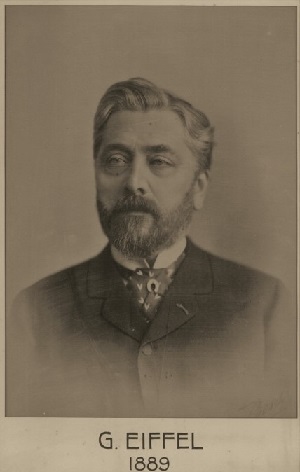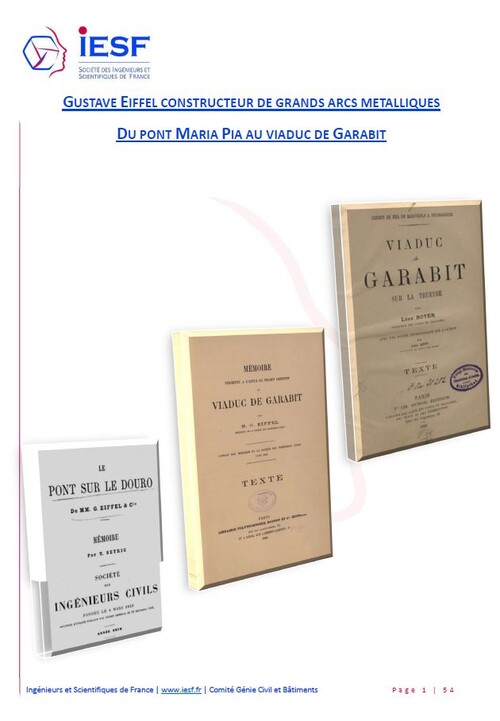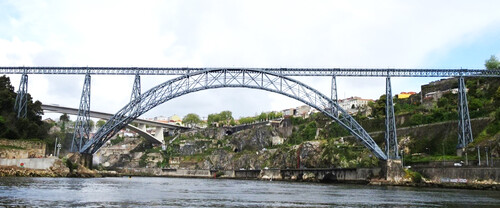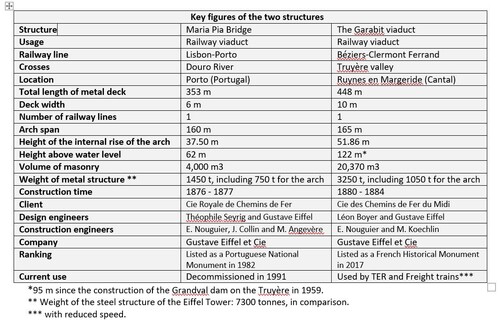Gustave Eiffel and his construction of metal arch bridges
Jean-François Coste et Bruno Godart
Gustave Eiffel is known worldwide as the builder of the Eiffel Tower on the Champ de Mars in Paris, but he is also remembered for having built metal railway structures, in particular metal arch bridges.
The two most emblematic structures are the Maria Pia Bridge over the Douro in Porto and the Garabit viaduct over the Truyère valley in the Cantal region of France. Jean-François Coste and Bruno Godart have taken on the role of historians of science and technology for the Civil Engineering and Building Committee of the French Society of Engineers and Scientists (IESF). Using the archives of the French Society of Civil Engineers and the National Library of France (BNF), they look back on the history of the design and construction of these two engineering structures.
The IESF’s historical links with Gustave Eiffel
The IESF has strong historical links with Gustave Eiffel. In 1880, Gustave Eiffel became a member of the French Society of Civil Engineers, the forerunner of the IESF. He became its president in 1889.
The design of the two metal arch bridges was the subject of several memoirs written by Gustave Eiffel himself, his associate Théophile Seyrig, who drew up the first design for the bridge over the Douro, and Léon Boyer for the Administration, who proposed an innovative alignment for the railway line, including a large viaduct over the Truyère valley. At that time, civil engineering projects were presented to the French Society of Civil Engineers, followed by reports kept at the IESF (1).
The IESF is taking part in the 2023 commemoration of the centenary of the death of the great engineer, entrepreneur and scientist Gustave Eiffel by highlighting twelve of his achievements. This is an opportunity to discover two of his metal railway bridges: the Maria Pia Bridge and the Garabit viaduct, which are remarkable in several respects and served as an example for the construction of later structures.

The wrought (puddled) iron arch: an innovation in crossing long-spanning obstacles
When Gustave Eiffel began designing the bridge over the Douro, he had already built major railway structures for more than 15 years: the Bordeaux metal railway bridge over the Garonne river (1858-1860), the railway bridges in Capdenac over the Lot river (1860-1861) and in Floirac over the Dordogne river (1860-1861), the bridge over the Adour river at Bayonne (1864), and the two large viaducts with metal piers at Rouzat and Neuvial along the Commentry - Gannat railway line (1868-1869).
What all these railway bridges have in common is the use of a deck consisting of a continuous metal lattice girder,2 the span lengths of which remain limited. The major innovation introduced for the Porto and Garabit bridges was the use of the arch, which would enable the bridge to cross long-spanning natural obstacles.
The use of wrought iron, a new material derived from cast iron that appeared in France from the 1850s, also made it possible to span much greater distances. The low carbon content of wrought (puddled) iron helps to improve its ductility3 and its mechanical properties compared with cast iron. The elements of a puddled iron arch will be able therefore to work in tension and compression, whereas cast iron elements can only work in compression.
Finally, the systematic use of material strength calculations made it possible to reduce the weight of structures compared with the older method of empirical dimensioning that led to an increase in reinforcements for safety reasons. The effects of wind were taken into account in the structure's design, and this expertise was subsequently decisive in designing the Eiffel Tower and adapting its shape to the effects of the wind.
There were also innovations in the actual construction of the two bridges, in order to reduce costs and construction deadlines.. The metal components of the arch and deck were prefabricated in a factory before being assembled on site. The cantilever construction method 4 used for the arches and the launching5 of the decks reduced the use of scaffolding. The metal elements were painted to prevent corrosion of the wrought iron and reduce maintenance costs.

Ever-advancing civil engineering techniques
Civil engineering techniques have come a long way since the end of the 19th century. Structural engineering for bridge design was in its infancy. At that time, calculations were limited to elasticity, with a simplified integration of the effects of temperature and wind. Calculations have since been enhanced to take into account such factors as limit states, the probabilistic approach and safety coefficients, arch buckling, ...
There have also been major advances in materials science, with the replacement of wrought (puddled) iron by steel from 1900 onwards, and the continual improvement in the performance of steels, the increased thickness of steel sheets, the development of low-carbon steels and the use of Corten steels and recycled steels.
Despite this progress, the construction methods tested on the two structures are still in use: prefabrication of elements in the factory, assembly of elements on site, launching and/or cantilevering of the deck. The launching method was used, for example, on the Millau Viaduct and the Simone Veil Bridge in Bordeaux.
At the end of the 19th century, the design of structures was the subject of memoirs presented to scientific societies or even published and widely distributed, such as Gustave Eiffel’s memoir presented in support of the final plans for the Garabit viaduct. Unfortunately, the design and construction of structures are no longer the subject of such detailed memoirs. There are primarily technical articles describing new constructions, but they do not present the calculation methods used to design the structures.
In 1893, Gustave Eiffel resigned from his position as head of his company and turned his attention to the sciences. After studying the effects of air resistance on objects falling from the top of the Eiffel Tower, in 1912 he set up the first experimental aerodynamics laboratory equipped with a wind tunnel, at 67 rue Boileau in Paris. The Eiffel wind tunnel is still in operation and run by the CSTB. Initially used in aeronautics and car manufacturing, in 1945 it was used to design bridges resisting the wind.
Metal bridges today
Nowadays, large-spanning bridges are still needed, and steel continues to be used for its mechanical properties, for the construction of large arches and suspension or cable-stayed bridges.
Metal arch bridges continue to break records for their span, notably in China with the Chaotianmen Bridge (552 m span, 2009) and the Lupu Bridge (550 m span, 2003).
Among the cable-stayed or suspension bridges are the Millau Viaduct (6 spans of 342 m, 2001-2004), the third bridge over the Bosphorus, the Yavuz Sultan Selim Bridge (1,408 m span, 2013-2016) and the bridge over the Dardanelles Strait, the Çanakkale Bridge6 (2,023 m span, 2017-2022).
Steel decks are also used in urban environments for river bridges, where the constraints of navigation gauges and urban development often require the use of thin metal decks, as in the case of the sixth bridge in Bordeaux, the Simone Veil Bridge.
Most of the new pedestrian and cycle bridges are made of metal and often have original architectural forms, such as the Simone de Beauvoir footbridge in Bercy (2004-2006) or the urban bridge in Pleyel.
Steel structures still have a bright future ahead of them.
1 The IESF holds all the memoirs and reports on the work of the French Society of Civil Engineers published between 1848 and 1925. This archive has been fully digitised by the Conservatoire National des Arts et Métiers (CNAM) and can be accessed via its digital library.
2 A lattice girder is one that is made up of two metal beams, called flanges, connected by diagonals forming cross-braces.
3 Ductility is the ability of a material to deform plastically without rupture.
4 Cantilevering consists of building the arch without props or scaffolding. Each segment of arch being built is supported by the segment previously built. The arch is cantilevered over the void, supported by steel cables temporarily fixed to the deck. Construction is completed when the two parts of the arch meet and the key is fitted.
5 The metal deck elements are assembled on either side of the river and placed on rollers or sliding supports. The two parts of the deck are then pushed over the void as construction progresses, so that they pass successively over the pillars that have already been built, bringing the two parts of the deck together. This operation is called launching or incremental launching.
6 The Çanakkale Bridge currently holds the world record for the largest suspension span: 2,023 m in length.
Experts interviewed
Jean-François Coste
Jean François Coste began his career in 1962 as a Ponts et Chaussés engineer in charge of Paris bridges over the Seine: project manager for the reconstruction of four bridges, including three metal ones, and for the design of the Alma Bridge. He continued his career in the field as Director of the DDE of Morbihan and then Bouches du Rhône, before being appointed director of LCPC from 1987 to 1997.
Bruno Godart
After graduating from the National School of State Public Works in 1978 and obtaining a Master of Science from Stanford University in 1979, Bruno Godart began his career at the LCPC, where he was Technical Director for Engineering Structures. He then worked at IFSTTAR before continuing his career as Deputy Director of the Materials and Structures Department at Université Gustave Eiffel.
The interview was conducted by the DSOS department at Université Gustave Eiffel.
Identity card of the article
| Title: | Gustave Eiffel and his construction of metal arch bridges |
| Experts interviewed: | Jean-François Coste and Bruno Godart |
| License: | This article is published under license CC BY-SA 4.0. |
| Publication date: | March 4, 2024 |
| Languages: | English anf french |
| Keywords: | Gustave Eiffel, Maria Pia Bridge, Garabit viaduct, metal arch bridges, wrought iron, material strength |





![[Translate to English:] Licence creative commons BY-SA 4.0 [Translate to English:] Licence creative commons BY-SA 4.0](https://reflexscience.univ-gustave-eiffel.fr/fileadmin/ReflexScience/Accueil/Logos/CCbySA.png)